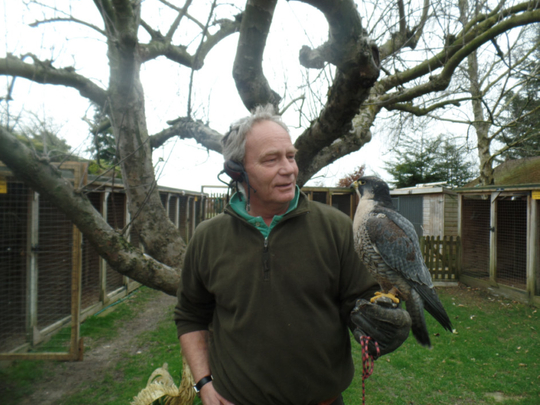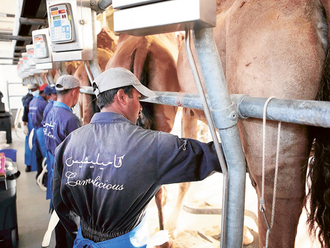
When David Hughes was about 17 years old, he ran away with a travelling circus to work with lions and tigers. Originally from North Yorkshire, he grew up in a small town.
One day he went to the job centre and came across an advertisement for an assistant lion trainer on a travelling circus. “I thought that would be a pretty good laugh,” he tells Weekend Review.
However, his parents didn’t see it that way.
“They told me to grow up and stop living in a fairytale,” he says.
The circus took him all around the United Kingdom, and his chores included feeding the lions and tigers, grooming them, and mucking out their cages. And he had to spend lots of hours with lion cubs, much as you would do with a puppy or kitten — and he still has the scars to prove it. “I got bitten straight through the arm by a tiger cub,” Hughes says.
Seven years on, Hughes moved over to bears and elephants — and also met his future wife. Now, 30 years on, Hughes makes his living training and giving people experiences with a different type of predator — birds of prey.
“It sounds silly but training a lion and a tiger in the circus field is very much like training a bird of prey,” he says. “It is amazing. Food as a reward. The only difference is where we have various weights for the bird, we have a flying weight and a hunting weight.”
Hughes gives Weekend Review a guided tour of the birds he keeps at Hawkwalk, his family-owned centre for falconry and birds of prey in Oxfordshire. The birds are in large separate cages in the back garden of his home. They include a variety of falcons, kestrels, sparrow hawks, goshawks, buzzards, red kites and owls — even a raven with a large beak.
Its speciality is British birds.
“A lot of people don’t know what our own British birds look like,” he says. “When you look at a lot of shows, they are using American birds, African birds, Asian birds. People get to the point they can go into a show and say: ‘oh look, there is an American kestrel there.’ But when they go next door they ask, ‘what kind of bird is that?’ It is an English kestrel.”
Pleasant environment
In an open field behind the garden, the countryside air is refreshing and welcoming. It’s a pleasant environment, and Hughes keeps horses, donkeys and sheep.
He offers Hawkwalk which features a full- or a half-day event, hunting and a falconry course. The walks include handling and flying the birds as well as going into the fields.
“We grab the hawks, grab the dogs, grab the ferrets and we literally go out onto the local farms hunting for rabbits. During the winter, we might capture some pheasants or partridge where we would actually particularly physically go out with the intent of eating something for tea that night,” he says.
Halkwalk also provides night experiences. “We take people out into the fields, we fly the owls at night. Night torches, no headlights, no spotlights, so we actually fly the owls in the dark at night.”
It’s work that takes him all over the country for audiences of between 50 and 1,000. “We did Romsey show, which is a huge one-day show, and there would probably be about 5,000 to 6,000 people there.”
He also takes his peregrine falcons, owls and kite to schools.
“We take birds in that would suit the curriculum. You can involve falconry in geography, biology, history, maths,” he says.
Hughes’s family shares his interest in outdoor pursuits — his wife keeps horses, his son is a tree surgeon, and his daughter takes an interest in birds and horses.
“I think if the parents are outside orientated, it encourages the kids to go outside a little bit,” he says. “If you have got parents who sit all day in an office on a computer typing away, when they come home all they want to do is sit there and watch telly and chill out. When the kids come home, what are they going to do? Sit home and watch telly.”
There is an adrenaline buzz in watching the birds work.
“You are pitting feather against fur,” he says. “It is the ultimate form of hunting. You haven’t got a gun, you haven’t got a bow and arrow. You haven’t got a spear, you haven’t got a catapult. It’s animal against animal. I get quite excited. It is probably the closest that 99.9 per cent of people will actually get to seeing hunting in the wild.
“A hawk sitting on the tree dropping down to catch a rabbit. Yes, they see it on telly. David Attenborough with his wild life programmes etcetera. You see it on telly. But to be here, well there is a hawk in the tree there dropping out and chasing that rabbit. You are there, you are part of it. How many people experience that? In my eyes, they are missing out big time. Greed has become part of our society.”
Hughes says ignorance plays a large part in today’s society.
“People have forgotten what it was like when you had to go out and get your own food,” he enthuses. “Prime example — cities. How many people who live in the city have a garden? They don’t know the experience of growing their own vegetables.
“I have been to schools and kids haven’t got a clue. I have been asked where does milk come from? They think in comes from Tesco, where Mum and Dad go.”
His clients come from all walks of life. He has had surgeons, members of parliament, the unemployed, CEOs of businesses and banks, train drivers, lorry drivers and a bin man. He estimates that 85 per cent of the time, these are people who have been bought gifts by someone else.
He also uses the raven at weddings. The bird flies down the aisle to present the wedding rings. “Lot of people use owls, we use owls as well, but we have had a lot of interest in using the raven.”
Once, he had a female client who wanted to propose using a falcon. According to tradition, a woman can propose to a man during a leap year. The couple were out for an ‘experience day’ with Hughes.
“We had a little roll of paper slid through the anklets on the bird, and the bird came down on the bloke, and he pulled this piece of paper out. And it said: ‘will you marry me?’ I stood back a bit, just to give them a little bit of a private moment, and then next thing I knew — bear in mind we are out in the middle of the Oxfordshire countryside, Hawks in the trees, dogs working away — and he went off in one direction, and she went off in the other direction in tears. He had obviously said no.”
Hughes bought his raven from someone who used to breed for the Tower of London. “You would be surprised how many people wouldn’t know what she was,” he says. “‘Why have you got a crow?’ I think she has even been called a kingfisher. This big greens and oranges and reds. Somebody actually thought she was a cookaroo.”
He describes her as almost mischievous. “I was at a show somewhere, and I dropped my glasses. She went ‘oh, I will have that.’ And I was chasing her around the show. Raven, can I have my glasses back? I mean ravens are very intelligent birds. I will actually classify them as an honourary hawk because in the wild they will hunt and kill things.”
The raven eats a variety of food. “She gets fed day-old chicks, mice, rabbit,” he says.
On one shelf of his workshop, which is filled with falconry-related equipment, are more than a dozen hoods for the birds to wear. He shows the mangler — heavy glove he uses to handle the birds — allowing the birds to sit on the same perch while the mangler is passed to those in the audience.”
Hughes makes or mends his own equipment, and often finds himself working from seven in the morning until late at night in the workshop.
For instance, he will work on leather anklets that go around the birds’ legs.
“All the leather work I make myself,” he says. “You can buy it but is that falconry? Surely, part of falconry is making your own equipment. It is easy, it is only some leather, a scalpel and a bit of common sense.”
He also has a century-old sewing machine that comes in handy for stitching bits and pieces together. “If I have got a hole in the glove, I can fix it. It is not brilliant but it does exactly what I want it to do. It is a sewing machine. It is almost like it is fitted with falconry — it is old.”
He also keeps a scale with weights to measure the birds.
“I have a book with 30-years’ worth of birds’ weights in there. Dates, weather, temperatures,” he says. Keeping measurements is important as birds fly back to their handlers’ glove for food.
“If you have got a bird that is too heavy, it flies but it flies off. You have then got to go and look for it,” he adds.
He has had clients from faraway places such as Germany, France, Australia, New Zealand and America. There is also potential for the many falconry and birds of prey enthusiasts in the Middle East to visit the Oxford countryside and enjoy a different sort of experience.
“The United Arab Emirates are very big into falconry. And there is a lot of them come over here for holidays. It would be nice if you could sort of get into that sort of side and offer them to come out and hunt. Come out into England — you have been out in the deserts and Saudi and Dubai, you have been in the sand — come out to the Oxfordshire rural country, grass, green trees — and experience a different type of falconry,” he says.
Syed Hamad Ali is a writer based in London.











